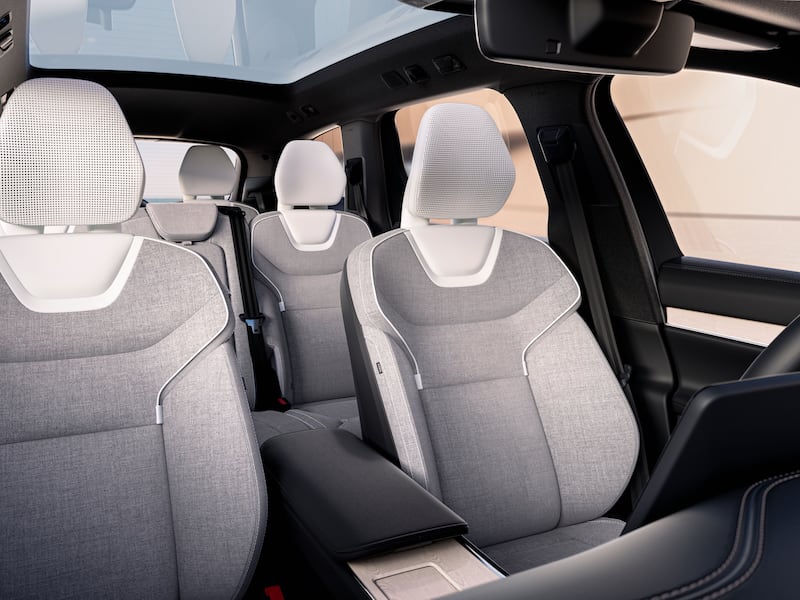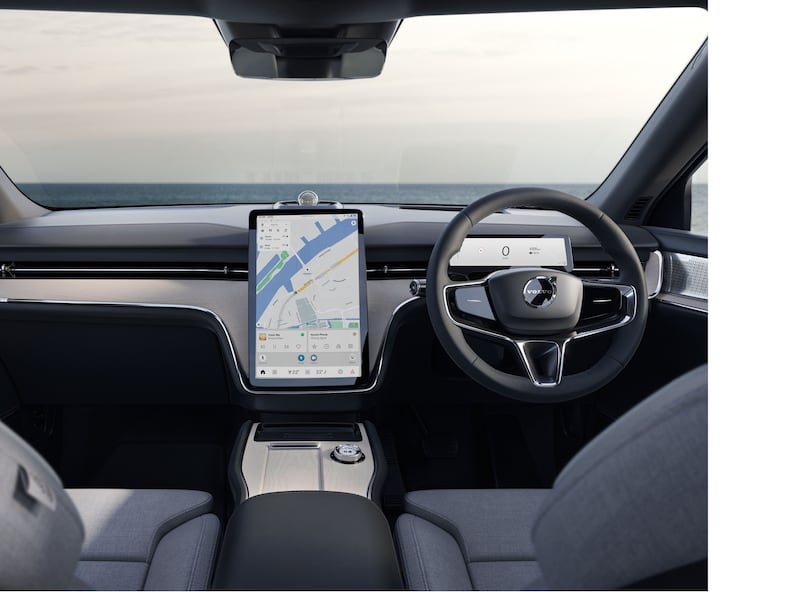Check out any school run in a well-heeled area of Ireland and I pretty much guarantee you’ll find at least one Volvo XC90 in amid the shoal of other cars. The big seven-seat Volvo SUV has been almost ubiquitous in some parts of the world, and it’s not hard to see why. Buy one and you get BMW and Mercedes levels of comfort, refinement and quality but with a far more caring and sharing image, with much less of the ostentatious thrusting of the German marques.
You also get safety, safety of a sort not previously seen in the automotive world. Indeed, Volvo has some figures that suggest that in the 20-odd year production history of the two generations of XC90, not a single occupant of one has been killed in a crash. Safe? A bank vault has nothing on an XC90.
That is a tradition which Volvo very much hopes to carry on with this, the new EX90. Style-wise, it’s not a radical departure from the current XC90 (which will continue on sale for a while yet at a plug-in hybrid) but underneath it’s all new, using the latest SPA2 electric-only architecture. That means while you will be able to choose between two four-wheel drive variants and, eventually, a single-motor rear-wheel-drive model, there will never be a combustion-powered EX90.

Is that going to present Volvo with a problem in a world where electric car sales are shrinking? Not to judge by Irish sales. Even with a €117,900 price tag for the current most affordable version, the EX90 is sold out for the entirety of this year, with the first customer cars due to arrive in July.
RM Block
Initially, the EX90 will arrive with one battery option – a pack with a 107kWh net capacity – and a choice of two four-wheel drive versions, packing either 498hp or 517hp which is enough to shove it to 100km/h in just 4.9 seconds. That’s monstrous performance for a car weighing close to three tonnes.
You’d think that such power and performance would lead to equally monstrous insurance premiums, but no – even flint-hearted Irish insurers still regard Volvo as a literally safe bet, and so there’s apparently no major insurance penalty for all that oomph.
Volvo’s safety credentials are undimmed, but how do you keep them going when this EX90 replaces apparently the safest car ever? There’s a one-word answer – Lidar. Well, in fairness, Lidar is technically a two-word answer that’s a portmanteau of laser and radar. There’s a forward-facing Lidar scanner mounted where the roof meets the EX90′s windscreen, giving it a small hump that from some angles makes the EX90 look like an off-duty taxi.
Still, the potential improvement in active safety is close to incredible. Lidar has often been touted at the missing piece in fully-autonomous driving, allowing cars to create a live 3D map of everything that’s around them, millisecond by millisecond. Volvo, in this instance, is leveraging that fidelity to scan the road ahead – as much as 200m ahead, depending on the conditions – and the Lidar can see further ahead than you or your headlights and can pick out black objects against a dark background. Tie that into a warning and automated braking setup and you have serious potential to save lives.
With thousands of existing XC90 customers around the world, Volvo has not tried to dramatically reinvent things with the EX90, so aside from the front – which looks very much like a scaled-up EX30, with that blunt face and pixelated ‘Thor’s hammer’ headlights (Volvo was into Thor before Marvel made it cool) – the EX look very, very similar in profile to an XC. There’s no danger here of a Mercedes EQS SUV formless blob look, nor of a BMW iX’s disjointed style. It’s quiet, but handsome.

That’s true of the cabin, which is stripped right back to luxurious essentials. There are almost no physical buttons (which always gets a down-vote from us) but there is an impressive-looking 14.5-inch touchscreen. The screen uses broadly similar software to that which annoyed us so much in the EX30, but at least here it doesn’t have to double-duty as an instrument panel, because there’s one of those behind the steering wheel. Volvo says that the software is designed to improve, and that owners will be given major updates and upgrades six to eight times a year, potentially making the EX90 a better car when you sell it than when you buy it. We shall see...
Elsewhere, the cabin is beautifully made with plenty of useful storage space. The car we were allowed to poke around had the optional wool-blend upholstery, which looks and feels far more welcoming and luxurious than the imitation leather option. There’s acres of space in the back seats, although the centre rear seat is for skinny people only. Behind them is the folding boot seats, which are just about large enough to cope with your chunky-XL correspondent. Fold them away, and there’s a vast 650-litre boot, and even with people in them there’s 310 litres of space to play with, plus – at last! – space under the boot floor to stow the luggage cover.
For all its weight and space the EX90 ought to be fairly efficient. Volvo claims 21kWh/100km battery economy, which isn’t too shabby, and its starting carbon footprint should be okay too, thanks to lots and lots of recycled plastic, steel and aluminium in the car.
Unlike the EX30, which has to come all the way from China, the EX90 is built in the United States, so that helps too. It can also charge your house, thanks to two-way charging built-in (ESB allowing…) while when you need to top up quickly when you’re out and about it’ll take a 250kW charge from a DC rapid-charging point. There’s 11kW AC charging for now, but Volvo says this is likely to be upgraded, via a software update, to 22kW at some point. Range? About 580km for either of the four-wheel drive versions, but the eventual two-wheel drive model – in spite of a slightly smaller battery – should just poke through the 600km barrier.
The EX90 also seems to be something of an underlined restart for Volvo. One Volvo insider said to us: “We’re back to being an engineering company again, not a marketing operation.” That is hopefully true, but either way the EX90 is also the start of a new era of making cars for Volvo, one where the ‘platform’ on which its cars are based is now defined not by pressed metal but by the computing system, which is now more expensive to make than the pressed metal bits. The EX90 uses a ‘core computing’ system designed by American computing giant Nvidia, and that can apparently cope with 280 trillion operations per second – supercomputer stuff.
Which makes the EX90 rather an enticing combination of contrasts. It’s a supercomputer on wheels, yet one that has traditional Scandinavian comfort and luxury, and seats made of genuine sheep’s wool. It’s huge, hulking and weighs (almost) three tonnes yet uses low-carbon steel, lots of recycled material and has zero emissions at the point of use. It’s a proper bank-vault safe Volvo, but it has the power and performance of a 1990s Ferrari.
It’s also expensive as Hela, but still less pricey than its rivals from BMW and Mercedes (although watch out for the brilliant Kia EV9 catching up in the outside lane) and it’s a sales success in a world that seems to have suddenly lost its appetite for EVs. Quite what that will all mean when we finally get to drive it is anyone’s guess, but at least the EX90 proves without question that electric cars aren’t boring.
- Listen to our Inside Politics Podcast for the latest analysis and chat
- Sign up for push alerts and have the best news, analysis and comment delivered directly to your phone
- Find The Irish Times on WhatsApp and stay up to date


















